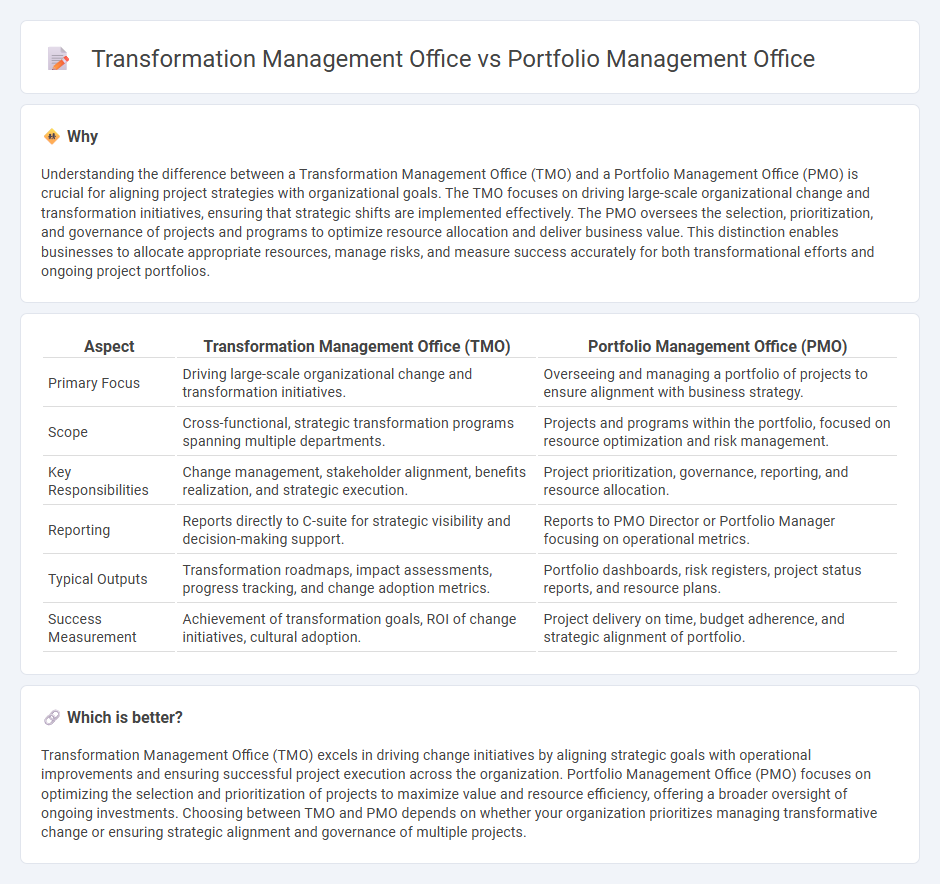
Transformation Management Office (TMO) focuses on overseeing large-scale strategic change initiatives, ensuring alignment with organizational goals and delivering intended business outcomes. Portfolio Management Office (PMO) centers on managing a collection of projects and programs to optimize resource allocation, risk management, and performance monitoring. Explore the distinct roles and benefits of TMO and PMO to enhance your organization's change and project management capabilities.
Why it is important
Understanding the difference between a Transformation Management Office (TMO) and a Portfolio Management Office (PMO) is crucial for aligning project strategies with organizational goals. The TMO focuses on driving large-scale organizational change and transformation initiatives, ensuring that strategic shifts are implemented effectively. The PMO oversees the selection, prioritization, and governance of projects and programs to optimize resource allocation and deliver business value. This distinction enables businesses to allocate appropriate resources, manage risks, and measure success accurately for both transformational efforts and ongoing project portfolios.
Comparison Table
| Aspect | Transformation Management Office (TMO) | Portfolio Management Office (PMO) |
|---|---|---|
| Primary Focus | Driving large-scale organizational change and transformation initiatives. | Overseeing and managing a portfolio of projects to ensure alignment with business strategy. |
| Scope | Cross-functional, strategic transformation programs spanning multiple departments. | Projects and programs within the portfolio, focused on resource optimization and risk management. |
| Key Responsibilities | Change management, stakeholder alignment, benefits realization, and strategic execution. | Project prioritization, governance, reporting, and resource allocation. |
| Reporting | Reports directly to C-suite for strategic visibility and decision-making support. | Reports to PMO Director or Portfolio Manager focusing on operational metrics. |
| Typical Outputs | Transformation roadmaps, impact assessments, progress tracking, and change adoption metrics. | Portfolio dashboards, risk registers, project status reports, and resource plans. |
| Success Measurement | Achievement of transformation goals, ROI of change initiatives, cultural adoption. | Project delivery on time, budget adherence, and strategic alignment of portfolio. |
Which is better?
Transformation Management Office (TMO) excels in driving change initiatives by aligning strategic goals with operational improvements and ensuring successful project execution across the organization. Portfolio Management Office (PMO) focuses on optimizing the selection and prioritization of projects to maximize value and resource efficiency, offering a broader oversight of ongoing investments. Choosing between TMO and PMO depends on whether your organization prioritizes managing transformative change or ensuring strategic alignment and governance of multiple projects.
Connection
The Transformation Management Office (TMO) and Portfolio Management Office (PMO) are interconnected through their roles in strategic alignment and execution oversight within organizations. The TMO drives change initiatives and transformation programs, while the PMO manages the portfolio of projects ensuring resources, risks, and benefits are balanced for optimal value delivery. Their collaboration enables harmonized governance, improved decision-making, and enhanced organizational agility.
Key Terms
Governance
A Portfolio Management Office (PMO) primarily focuses on governance by standardizing project selection, prioritization, and resource allocation to ensure alignment with strategic objectives across the organization. In contrast, a Transformation Management Office (TMO) governs the execution of change initiatives, overseeing benefits realization, stakeholder engagement, and change impact management to drive successful business transformation. Explore how these governance frameworks can optimize organizational performance and strategic outcomes.
Strategic Alignment
A Portfolio Management Office (PMO) prioritizes aligning projects and programs with an organization's strategic goals to maximize value and resource efficiency. In contrast, a Transformation Management Office (TMO) focuses on driving and managing change initiatives that support long-term business transformation and agility. Explore how integrating strategic alignment in both PMO and TMO functions can enhance your organization's success.
Change Management
A Portfolio Management Office (PMO) primarily oversees project prioritization, resource allocation, and governance across an organization's entire portfolio, ensuring alignment with strategic business goals. In contrast, a Transformation Management Office (TMO) concentrates on driving organizational change initiatives, embedding change management practices to facilitate smooth transitions and stakeholder engagement during transformational projects. Explore deeper insights into how PMOs and TMOs uniquely contribute to effective change management within enterprises.
Source and External Links
The Rise of the Portfolio Office - A Portfolio Management Office oversees a collection of projects from concept to delivery, managing pipeline, aligning projects with strategy, monitoring performance, and providing visibility to maximize strategic investment value.
Portfolio Management Office: Questions and Answers - The Portfolio Management Office ensures strategic alignment, selects and prioritizes projects, and establishes standards and frameworks to support consistent and effective portfolio management.
Portfolio Management Office - A team of IT professionals managing complex projects with services in project management, business analysis, process improvement, and change management to achieve successful project outcomes and strategic objectives.
 dowidth.com
dowidth.com